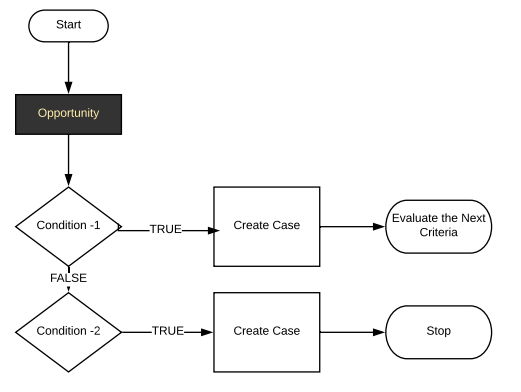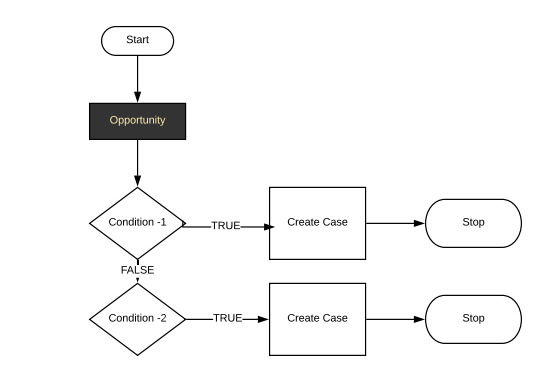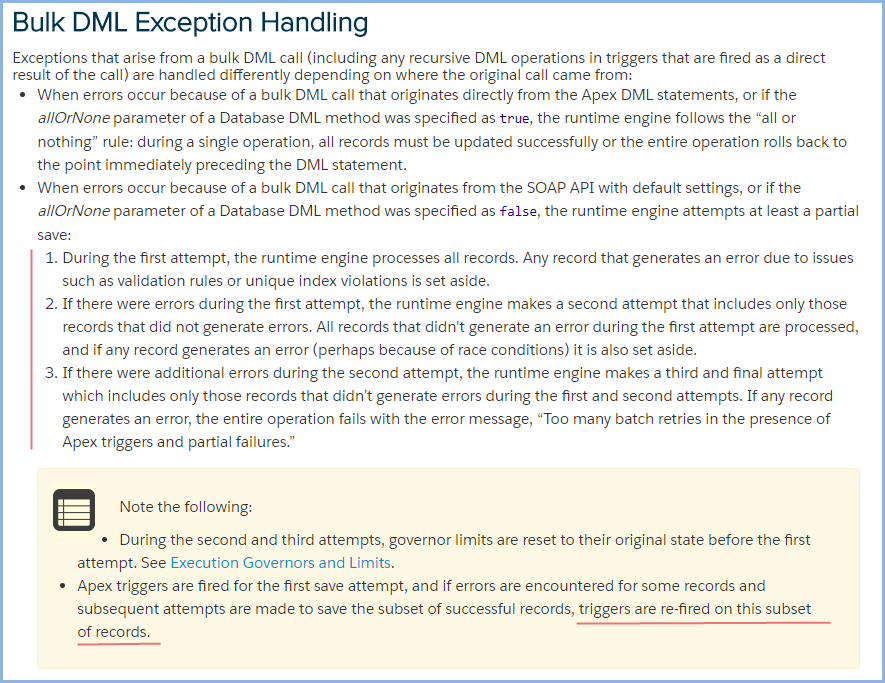Part four of a series. Posts include:
Let’s say you have an Opportunity domain method called applyDiscounts(). I’ve seen two approaches to coding (and invoking) this method:
Purist Approach
public void applyDiscounts() {
for (Opportunity o : (Opportunity[]) Records) {
.. do work, modifying Records ..
}
}
Invoke this by:
Opportunities.newInstance(myOppos).applyDiscounts();
Easier To Mock Approach
public void applyDiscounts(Opportunity oppos) {
for (Opportunity o : oppos) {
.. do work, modifying calling argument oppos
}
}
Invoke this by:
Opportunities.newInstance().applyDiscounts(myOppos);
I don’t really like the second approach because it perverts the intention of the Domain class which is to operate on a collection of SObjects provided through its constructor and available in super class variable Records. The Andrew Fawcett book on Enterprise patterns illustrates a custom domain method using the first approach on page 184 (second edition).
If you are using the second approach, you can mock the results of the void method applyDiscounts(oppos) using fflib_Answer. You use Answers when the mocked method returns modified values through its arguments. Enzo Denti has an excellent blog post on how to do this and I won’t bother to repeat this.
But let’s assume you are using the purist approach and need to mock the results of a void domain class method that modifies values passed to the domain class’s constructor. How would you do that?
Assume you have a class DoCoolOpportunityStuff that among other things, has a dependency on the Opportunities domain class and specifically the domain class’s applyDiscounts() method. Let’s set this up:
DoCoolOpportunityStuff (could easily be a service layer class)
public with sharing class DoCoolOpportunityStuff {
public void doApplyDiscounts(Set<Id> oppoIds, fflib_ISObjectUnitOfWork uow) {
// Dependency 1 - Opportunity SObjects
Opportunity[] oppos = OpportunitiesSelector.newInstance().selectById(oppoIds);
// Dependency 2 - Opportunity Domain
Opportunities.newInstance(oppos).applyDiscounts();
for (Opportunity o: oppos) {
if (o.Amount < 0.00) {
Messaging.SingleEmailMessage email = new Messaging.SingleEmailMessage();
email.setSubject(o.Name + ' discounted more than 100%');
uow.registerEmail(email);
}
uow.registerDirty(o);
}
}
}
The above method doApplyDiscounts fetches Opportunities based on a set of ids (Dependency 1) and then instantiates a domain class (Dependency 2) to calculate the discounts on the Opportunities. If the applied discount is more than 100%, it sends an email telling someone of the overly-zealous discount. Everything is done through the UnitOfWork layer so results can be easily tested using ApexMocks.
So, to test this with mocks, we need to mock the Selector (to return mock Oppos) but for good unit tests, we need to also mock applyDiscounts to return changed Opportunities some with Amounts greater than 0.00 and some with Anounts less than 0.00.
Here’s what we need to do in the test method:
static void givenOpportunitiesVerifyApplyDiscounts() {
Opportunity[] mockOppos = new List<Opportunity> {
new Opportunity(Id=fflib_IDGenerator.generate(Opportunity.SObjectType),
Amount=10.0),
new Opportunity(Id=fflib_IDGenerator.generate(Opportunity.SObjectType),
Amount=20.0)
};
Set<Id> mockOppoIds = new Map<Id,Opportunity>(mockOppos).keySet();
fflib_ApexMocks mocks = new fflib_ApexMocks();
// Given mocks for each of the dependencies
OpportunitiesSelector mockOpportunitiesSelector = (OpportunitiesSelector) mocks.mock(OpportunitiesSelector.class);
Opportunities mockOpportunitiesDomain = (Opportunities) mocks.mock(Opportunities.class);
fflib_SObjectUnitOfWork mockUow =
(fflib_SObjectUnitOfWork) mocks.mock(fflib_SObjectUnitOfWork.class);
mocks.startStubbing();
mocks.when(mockOpportunitiesSelector.SObjectType())
.thenReturn(Opportunity.SObjectType);
mocks.when(mockOpportunitiesSelector.selectById(mockOppoIds))
.thenReturn(mockOppos);
mocks.when(mockOpportunitiesDomain.sObjectType())
.thenReturn(Opportunity.SObjectType);
((IOpportunities) mocks.doAnswer(
new MyApplyDiscountAnswer(mockOppos),mockOpportunitiesDomain))
.applyDiscounts();
mocks.stopStubbing();
// Given mocks injected
Application.Selector.setMock(mockOpportunitiesSelector);
Application.Domain.setMock(mockOpportunitiesDomain);
Application.UnitOfWork.setMock(mockUow);
// when service invoked
new DoCoolOpportunityStuff().doApplyDiscounts(mockOppoIds,mockUow);
// then verify oppos domain applyDiscounts called
((Opportunities)mocks.verify(mockOpportunitiesDomain,mocks.times(1)
.description('domain applyDiscounts sb called once')))
.applyDiscounts();
// then verify all mocked oppos registered dirty
((fflib_SObjectUnitOfWork)mocks.verify(mockUow,mocks.times(2)
.description('registerDirty sb called')))
.registerDirty(fflib_Match.sObjectOfType(Opportunity.SObjectType));
// then verify mocked Oppo[1] - mocked to discount more than 100%
// was noted in an email
((fflib_SObjectUnitOfWork)mocks.verify(mockUow,mocks.times(1)
.description('send email for oppo[1]')))
.registerEmail((Messaging.Email)fflib_Match.anyObject());
// then verify each Oppo (discounted) was dirtied with discount
((fflib_SObjectUnitOfWork)mocks.verify(mockUow,mocks.times(1)
.description('Oppo[0] should have discount')))
.registerDirty(fflib_Match.sObjectWith(
new Map<SObjectField,Object> {
Opportunity.Id => mockOppos[0].Id,
Opportunity.Amount => 0.50 * 10.00
}
));
((fflib_SObjectUnitOfWork)mocks.verify(mockUow,mocks.times(1)
.description('Oppo[1] should have > 100% discount')))
.registerDirty(fflib_Match.sObjectWith(
new Map<SObjectField,Object> {
Opportunity.Id => mockOppos[1].Id,
Opportunity.Amount => -10.00
}
));
}
Let’s focus on the mock answer for the applyDiscounts() method. Remember, it returns a value through the domain class’s Records variable (the opportunities provided to the domain class’s constructor. The other mocks for the selector and unit of work are standard issue mocks as described in earlier blog posts.
((IOpportunities) mocks.doAnswer(
new MyApplyDiscountAnswer(mockOppos),mockOpportunitiesDomain))
.applyDiscounts();
What do we have? We are telling ApexMocks that when the applyDiscounts method is called, answer with the side effects of class MyApplyDiscountAnswer.answer() using the mocked Opportunities (the ones the mocked selector returns). The class MyApplyDiscountAnswer looks like this:
class MyApplyDiscountAnswer implements fflib_Answer {
private Opportunity[] oppos;
private MyApplyDiscountAnswer(Opportunity[] oppos) {
this.oppos = oppos;
}
public Object answer(fflib_InvocationOnMock invocation) {
for (Integer i = 0; i < this.oppos.size(); i++) {
Opportunity o = this.oppos[i];
o.Amount = i ==1
? -10.00 // oppo 1 mocked to answer with negative amount
: 0.50* o.Amount;
}
return null; // answer must return something
}
}
You have to implement the answer method. Because we want to return some Opportunities with more than 100% discount applied, we need to dependency inject the Answer with the opportunities returned by the mocked selector. Meta-dependency-injecting! Fun!
So, what happens when the testmethod “when” executes?
new DoCoolOpportunityStuff().doApplyDiscounts(mockOppoIds,mockUow);
- The code under test starts
- The code under test fetches Opportunities using the supplied IDs
- Since we mocked the selector, the code under test fetches our testmethod’s
mockOppos
- These
mockOppos serve as the input to the Opportunities domain newInstance(..) method
- Since we mocked the domain class too, when the applyDiscounts method is requested; ApexMocks uses the custom Answer
MyApplyDiscountAnswer to take the mockOppos and modify them with amounts less than and greater than 0
- The code under test decides that some of the Oppos require an email (because we answered with Amount values less than 0.00). These emails are registered to the unit of work.
- The code under test finally takes each fetched Opportunity and registers it as dirty (with the discounted amount)
So, the rest of the testmethod simply verifies that the expected emails were registered to the unit of work and the expected sobjects were registered dirty. As with all comprehensive ApexMocks examples – no DML was required to be set up and no DML was executed making the test method lightning fast.
Now it must be admitted that this answer technique only works if you know outside of the code under test what objects will be provided to the domain class’s newInstance(..) method. It works in our example because we’re mocking the output of the selector as the input to the domain construction. And, the output of the selector is under the control of the testmethod .thenReturn(mockOppos) method n the mock stubbing section.
Another example – objects passed to domain constructor not knowable by testmethod
Let’s suppose we have a domain method that derives the ownerId for a collection of Opportunities. Further assume that this void assignOwners() method is really complicated and relies on a massive scaffolding of custom metadata and reference sobjects. Way too much to conveniently prebuild in DML for the testmethod
Further assume we have some service class method that exploits the domain class but the Opportunities passed to the domain constructor are not know outside of the service method:
public void doAssignOwners1(fflib_ISObjectUnitOfWork uow) {
Opportunity[] oppos = new List<Opportunity>();
// Contrived .. construct random # of Oppos. Dependency 1
for (Integer i = 0; i < Math.mod(System.currentTimeMillis(),5); i++) {
oppos.add(new Opportunity(Amount = i*100.00));
}
// Dependency 2 - Opportunity Domain
Opportunities.newInstance(oppos).assignOwners();
for (Opportunity o: oppos) {
uow.registerDirty(o);
}
}
I contrived the method to randomly generate Opportunities but the point being is that the method doAssignOwners isn’t passed predictable Opportunities.
While you could mock the domain class, you have no way in ApexMocks to mocking the opportunities passed to newInstance() and furthermore, even if you did (via a subclass of your Opportunities domain class), these mocked Opportunities wouldn’t flow to the for loop that registers dirty the opportunities that were randomly generated.
So, what to do?
You need to change the doAssignOwners method to have a mockable way of generating the opportunities for the domain class. Remember in our first example, the service method used a selector to generate the Opportunities for use in the domain class. So, we rewrite the service method to look like this:
public class DoCoolOpportunityStuff {
private final IOpportunityGenerator oppoGenerator;
public DoCoolOpportunityStuff() {
this.oppoGenerator = new OpportunityGenerator();
}
@TestVisible private DoCoolOpportunityStuff(IOpportunityGenerator mockOppoGenerator) {
this.oppoGenerator = mockOppoGenerator;
}
public void doAssignOwners2(fflib_ISObjectUnitOfWork uow) {
// Contrived .. construct random # of Oppos. Dependency 1
Opportunity[] oppos = this.oppoGenerator.generate();
// Dependency 2 - Opportunity Domain
Opportunities.newInstance(oppos).assignOwners();
for (Opportunity o: oppos) {
uow.registerDirty(o);
}
}
}
The Opportunities generated for use in the domain class come from another class and, because it is a top level class, we can mock that as well. Note above that the production code of DoCoolOpportunityStuff instantiates an object variable (using the no arg constructor) with the production version of the OpportunityGenerator (below). But we added in a way for the testmethod to use dependency injection to insert a test (mocked) version of this OpportunityGenerator so we can have predictability of the generated Oppos (and hence know which will be passed to the domain class’s newInstance(..) method).
public class OpportunityGenerator implements IOpportunityGenerator {
public Opportunity[] generate() {
Opportunity[] oppos = new List<Opportunity>();
for (Integer i = 0; i < Math.mod(System.currentTimeMillis(),5); i++) {
oppos.add(new Opportunity(Amount = i*100.00));
}
return oppos;
}
}
So, now we can test all this using everything we have learned as shown below:
@IsTest
private static void givenNothingVerifyAssignOwnersV2 () {
// Given mockOppos
Opportunity[] mockOppos = new List<Opportunity> {
new Opportunity(Id=fflib_IDGenerator.generate(Opportunity.SObjectType),
Amount=10.0),
new Opportunity(Id=fflib_IDGenerator.generate(Opportunity.SObjectType),
Amount=20.0)
};
Set<Id> mockOppoIds = new Map<Id,Opportunity>(mockOppos).keySet();
fflib_ApexMocks mocks = new fflib_ApexMocks();
// Given mockOpportunityGenerator
IOpportunityGenerator mockOpportunityGenerator =
(IOpportunityGenerator) mocks.mock(OpportunityGenerator.class);
// Given mock domain and uow
Opportunities mockOpportunitiesDomain = (Opportunities) mocks.mock(Opportunities.class);
fflib_SObjectUnitOfWork mockUow =
(fflib_SObjectUnitOfWork) mocks.mock(fflib_SObjectUnitOfWork.class);
mocks.startStubbing();
mocks.when(mockOpportunityGenerator.generate()).thenReturn(mockOppos);
mocks.when(mockOpportunitiesDomain.sObjectType())
.thenReturn(Opportunity.SObjectType);
((IOpportunities) mocks.doAnswer(
new MyAssignOwnerAnswer(mockOppos),mockOpportunitiesDomain))
.assignOwners();
mocks.stopStubbing();
// Given mocks injected
Application.Domain.setMock(mockOpportunitiesDomain);
Application.UnitOfWork.setMock(mockUow);
DoCoolOpportunityStuff coolStuff = new DoCoolOpportunityStuff(mockOpportunityGenerator);
// when service method called
coolStuff.doAssignOwners2(mockUow); // assigns owners
// verify each oppo updated and w/ owner
((fflib_SObjectUnitOfWork)mocks.verify(mockUow,mocks.times(2)
.description('2 recs sb modified')))
.registerDirty(fflib_Match.sObjectOfType(Opportunity.SObjectType));
((fflib_SObjectUnitOfWork)mocks.verify(mockUow,mocks.times(2)
.description('each domain oppo should have ownerId as per our mocked Answer')))
.registerDirty(fflib_Match.sObjectWith(
new Map<SObjectField,Object>{
Opportunity.OwnerId => UserInfo.getUserId()
}));
}
These lines set up the mockOpportunityGenerator and then inject it to the code under test
// Given mockOpportunityGenerator
IOpportunityGenerator mockOpportunityGenerator =
(IOpportunityGenerator) mocks.mock(OpportunityGenerator.class);
...
// inject via testVisible constructor
DoCoolOpportunityStuff coolStuff = new DoCoolOpportunityStuff(mockOpportunityGenerator);
And to mock the no arg domain class method assignOwners(), we use the same Answer technique in the first example:
((IOpportunities) mocks.doAnswer(
new MyAssignOwnerAnswer(mockOppos),mockOpportunitiesDomain))
.assignOwners();
Here we have a different custom fflib_Answer type (see below). This custom Answer assigns the owners to something predictable like the running user’s ID.
class MyAssignOwnerAnswer implements fflib_Answer {
private Opportunity[] oppos;
public MyAssignOwnerAnswer(Opportunity[] oppos) {
this.oppos = oppos;
}
public Object answer(fflib_InvocationOnMock invocation) {
for (Integer i = 0; i < this.oppos.size(); i++) {
Opportunity o = this.oppos[i];
o.OwnerId = UserInfo.getUserId();
}
return null; // answer must return something
}
}








